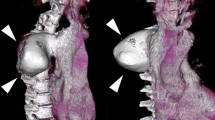Abstract
Background
The transsylvian approach is a versatile treatment method for aneurysms of the anterior circulatory system. Studies have shown that sylvian veins run in various patterns, suggesting the need for dissection between veins to obtain appropriate surgical corridor. In case of inadvertent sylvian vein injury, serious complications such as venous congestion may occur.
Method
We herein describe the “side-to-side anastomosis reconstruction technique” of the resected superficial sylvian vein.
Conclusion
This technique can be effective for the reconstruction of other cortical veins, and indocyanine green videoangiography was effective in determining the indications for venous reconstruction.



Similar content being viewed by others
References
Ferroli P, Acerbi F, Tringali G, Albanese E, Broggi M, Franzini A, Broggi G (2011) Venous sacrifice in neurosurgery: new insights from venous indocyanine green videoangiography. J Neurosurg 115:18–23
Hasegawa H, Inoue T, Sato K, Tamura A, Saito I (2013) Mobilization of the sphenoparietal sinus: a simple technique to preserve prominent frontobasal bridging veins during surgical clipping of anterior communicating artery aneurysms: technical case report. Neurosurg 73:onsE124-127
Kazumata K, Kamiyama H, Ishikawa T, Takizawa K, Maeda T, Makino K, Gotoh S (2003) Operative anatomy and classification of the sylvian veins for the distal transsylvian approach. Neurol Med Chir (Tokyo) 43:427–433
Kyoshima K, Oikawa S, Kobayashi S (2001) Preservation of large bridging veins of the cranial base: technical note [technical note]. Neurosurg 48:447–449
Maekawa H, Hadeishi H (2015) Venous-preserving Sylvian dissection World Neurosurg 84:2043–2052
Morita A, Sekhar LN (1998) Reconstruction of the vein of Labbé by using a short saphenous vein bypass graft. Technical note [technical note]. J Neurosurg 89:671–675
Nakase H, Shin Y, Nakagawa I, Kimura R, Sakaki T (2005) Clinical features of postoperative cerebral venous infarction. Acta Neurochir (Wien) 147:621–626
Ohara K, Inoue T, Ono H, Kiyofuji S, Tamura A, Saito I (2017) Technique for rerouting a bridging vein that hinders the anterior interhemispheric approach: a technical note. Acta Neurochir (Wien) 159:1913–1918
Sekhar LN, Chanda A, Morita A (2002) The preservation and reconstruction of cerebral veins and sinuses. J Clin Neurosci 9:391–399
Sugita K, Kobayashi S, Takemae T, Matsuo K, Yokoo A (1980) Direct retraction method in aneurysm surgery. Technical note [technical note]. J Neurosurg 53:417–419
Author information
Authors and Affiliations
Corresponding author
Ethics declarations
Ethical approval
In line with our Institution’s guidelines, the patient had consented to the submission of the case report to the journal.
Informed consent
The patient had consented to the submission of the case report to the journal.
Conflict of interest
The authors declare no competing interests.
Additional information
Publisher’s note
Springer Nature remains neutral with regard to jurisdictional claims in published maps and institutional affiliations.
Key points
• The SSV running pattern and derivation route should be carefully considered via preoperative cerebral angiography.
• The flap should be inverted in two layers to sufficiently expose the bone surface required for craniotomy.
• During craniotomy, the portion leading to SPS should be sufficiently exposed, bone should be sufficiently removed from the sphenoid ridge to the temporal base, and the lateral wall of the orbit should be sufficiently exposed.
• SSV outflow dynamics should be confirmed via ICG videoangiography and Doppler ultrasonography.
• Determine whether reconstruction via side-to-side anastomosis is possible or whether rerouting via end-to-side anastomosis is necessary.
• Ensure the stump of the dissected vein and reveal the anastomotic surface through methylrosaniline chloride (pyoctaninum blue) staining.
• Given that veins have lower pressure than arteries, the posterior wall is continuously anastomosed and the anterior wall is single anastomosed during anastomosis. Moreover, anastomosis is performed slightly loosely to prevent acute thrombosis [8].
• Reassess for the presence of obstruction and preservation of normal venous return intraoperatively using ICG videoangiography or Doppler ultrasonography.
• Dura mater reconstruction should be performed using the fascia while taking care not to induce venous obstruction due to dura mater attachment.
• The patency of the vein should be confirmed via CT venography or digital subtraction angiography early after the operation. If obstruction is suspected, introduction of anticoagulant therapy should be considered.
This article is part of the Topical Collection on Vascular Neurosurgery - Aneurysm
Supplementary Information
Below is the link to the electronic supplementary material.
Supplementary file1 (MP4 45688 KB)
Rights and permissions
About this article
Cite this article
Segawa, M., Inoue, T., Tsunoda, S. et al. How do I: Venous reconstruction of accidentally injured superficial sylvian vein during the clipping of an unruptured cerebral aneurysm. Acta Neurochir 164, 2547–2550 (2022). https://doi.org/10.1007/s00701-022-05184-z
Received:
Accepted:
Published:
Issue Date:
DOI: https://doi.org/10.1007/s00701-022-05184-z



